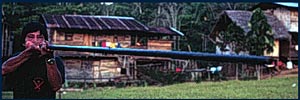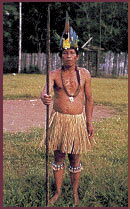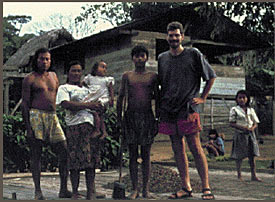Indigenous Ecotourism and Sustainable Development:
The Case of Río Blanco, Ecuador
David T. Schaller
Department of Geography
University of Minnesota
|
Note: This paper is based on research I conducted in 1995. I have not worked
in ecotourism research since then, so please don't ask me about current trends
in the field!
Versión Español
- Physical and Human Geography of Napo Province
- The Association of Río Blanco
- Case Study Methods: Quichua Interviews
- The Struggle for Land Tenure
- A Growing Community
- The Expansion of Agriculture
- The Reserves
 Summary:
The indigenous Quichua community of Río Blanco, in the Ecuadorian
Amazon (Napo Province), was founded in 1971 by Quichua migrants from the Andean
foothills, where, as a result of population growth and inmigration of mestizo
agricultural colonists, the supply of land was becoming short. Since 1971, the
economy of Río Blanco has shifted from one based almost entirely on subsistence
agriculture and hunting to one reliant on cash crops such as coffee, cacao,
rice and maize. Río Blanco has experienced high population growth in
the past twenty years which, along with a rising cost of living, has driven
the people of the community to expand greatly the amount of land under cultivation.
As a result, the amount of primary tropical forest has decreased until, in 1995,
it accounted for less than half of the community's main block of land. Facing
continued population growth, the community has developed an ecotourism project
as an alternative economic activity which may protect the forest rather than
clear it.
Summary:
The indigenous Quichua community of Río Blanco, in the Ecuadorian
Amazon (Napo Province), was founded in 1971 by Quichua migrants from the Andean
foothills, where, as a result of population growth and inmigration of mestizo
agricultural colonists, the supply of land was becoming short. Since 1971, the
economy of Río Blanco has shifted from one based almost entirely on subsistence
agriculture and hunting to one reliant on cash crops such as coffee, cacao,
rice and maize. Río Blanco has experienced high population growth in
the past twenty years which, along with a rising cost of living, has driven
the people of the community to expand greatly the amount of land under cultivation.
As a result, the amount of primary tropical forest has decreased until, in 1995,
it accounted for less than half of the community's main block of land. Facing
continued population growth, the community has developed an ecotourism project
as an alternative economic activity which may protect the forest rather than
clear it.
- What is Ecotourism?
- Tourism in Napo Province
- A Model for Indigenous Ecotourism Development
Summary: Ecotourism has attracted increasing attention in recent
years, not only as an alternative to mass tourism, but as a means of economic
development and environmental conservation. Proponents and some scholars
believe that it can potentially focus the benefits of tourism on the local
population and environment while minimizing negative impacts. Other observers
remain skeptical, warning that ecotourism has not yet been proven to be either
beneficial or sustainable. A growing number of researchers agree that local
control is key to avoiding many problems resulting from ecotourism development.
By scaling down production processes and returning power to local units of
governance, ecotourism may reduce economic leakages, minimize negative impacts
and concentrate the benefits locally. However, the international nature of
tourism creates many obstacles for localities wishing to maintain control of
their tourism industry. Too often, local people have neither the political
power nor the business connections to compete at an international level with
metropolitan tour agencies. Nevertheless, ecotourism's rapid growth has
attracted the attention of many people and communities in low-income countries.
In the Ecuadorian Amazon, a growing number of indigenous Quichua communities are
turning to ecotourism as an alternative to expanded commercial agriculture. Río
Blanco has joined a network of Quichua communities which are developing their
own ecotourism projects.
- Communal by Design
- Case Study Methods: Tourist Interviews
- Perceptions of the Tropical Forest
- Accuracy of the Ecotourism Experience
- Authenticity of the Ecotourism Experience
 Summary:
Two main tenets of Río Blanco's project are communal control
and small scale. Work is assigned equitably so all member-families of Río
Blanco contribute to and benefit from ecotourism. In the project's first year,
150 tourists visited. Each family earned about $100 in the first year, or about
one-fifth of their income for the year. Most members would like to receive about
300 tourists in 1996, thus maintaining the project's small scale. Tourists visiting
Río Blanco range from small groups of independent tourists to students
and teachers in groups of ten or twenty who are part of a tour run by a nearby
biological field station. A group of fifteen students interviewed after their
visit expressed satisfaction with their experience in Río Blanco, though
evidence suggests that their visit did not give them an accurate portrayal of
contemporary Quichua life. Whereas the people of Río Blanco rarely spend
time in primary forest, owing to their agricultural obligations, tourists spend
virtually all their time in primary forest. Few tourists interviewed believed
that commercial agriculture was a significant part of the community's economy,
indicating that they had learned little about a central aspect of community
life.
Summary:
Two main tenets of Río Blanco's project are communal control
and small scale. Work is assigned equitably so all member-families of Río
Blanco contribute to and benefit from ecotourism. In the project's first year,
150 tourists visited. Each family earned about $100 in the first year, or about
one-fifth of their income for the year. Most members would like to receive about
300 tourists in 1996, thus maintaining the project's small scale. Tourists visiting
Río Blanco range from small groups of independent tourists to students
and teachers in groups of ten or twenty who are part of a tour run by a nearby
biological field station. A group of fifteen students interviewed after their
visit expressed satisfaction with their experience in Río Blanco, though
evidence suggests that their visit did not give them an accurate portrayal of
contemporary Quichua life. Whereas the people of Río Blanco rarely spend
time in primary forest, owing to their agricultural obligations, tourists spend
virtually all their time in primary forest. Few tourists interviewed believed
that commercial agriculture was a significant part of the community's economy,
indicating that they had learned little about a central aspect of community
life.
However, many tourist-respondents were confused and even
upset by the cultural program, in which the people of the community wore the
traditional grass skirts and red body paint of their ancestors and performed
traditional Quichua music and dances. Many tourist-respondents questioned the
authenticity of these performances, since they appeared incongruent with
contemporary Quichua life. These concerns echoed scholarly research into
tourism and authenticity, which postulate both a touristic need for authenticity
and the ubiquity of "staged authenticity," which may only frustrate
the earnest seeker of true authenticity. Ironically, in Río Blanco the
rediscovery of traditional music and dance for tourism purposes may well lead to
its reincorporation into community festivals, increasing its authenticity in the
tourism program.
- Ecotourism as Development, Part One
- The Benefits and Costs of Ecotourism Development
- Ecotourism as Development, Part Two
- Threats to Ecotourism's Sustainability
- The Means and the Ends
Summary: The potential of Río Blanco's ecotourism project as
sustainable, appropriate development currently appears strong. While not all
Quichua respondents indicated that they saw the connection between tourism
development and forest preservation, a growing conservationist ethic among
members suggests that such a linkage may be evolving. It remains unclear,
however, how this ethic will affect agricultural activity. Most respondents
reported that they would rather increase tourism than agricultural production,
but nearly half also said they intended to clear more forest for cultivation.
Many members may have difficulty accepting the opportunity costs of further
ecotourism development. Until the community decides how much trust it can place
in ecotourism as a reliable and sustainable economic activity, agriculture will
probably continue to expand.
 In
the evaluation of development schemes, what is of prime importance for both
community members and the coordinators of Quichua ecotourism projects is the
survival of Quichua culture. If Río Blanco's ecotourism project does
not disrupt established social and political structures of the community, it
may qualify as appropriate development even though it is not a traditional form
of development. Furthermore, it may serve as a tool to help rural Quichua learn
business skills which are crucial if they are to succeed in dealings with mestizo
residents of the area as well as with other Ecuadorian and foreign parties.
In this way, ecotourism may not be an end in itself but merely a bridge to the
future. The sustainability of a particular ecotourism project may be irrelevant
in the long run. What matters is its impact on the local people and environment,
and how well it serves them against the challenges ahead.
In
the evaluation of development schemes, what is of prime importance for both
community members and the coordinators of Quichua ecotourism projects is the
survival of Quichua culture. If Río Blanco's ecotourism project does
not disrupt established social and political structures of the community, it
may qualify as appropriate development even though it is not a traditional form
of development. Furthermore, it may serve as a tool to help rural Quichua learn
business skills which are crucial if they are to succeed in dealings with mestizo
residents of the area as well as with other Ecuadorian and foreign parties.
In this way, ecotourism may not be an end in itself but merely a bridge to the
future. The sustainability of a particular ecotourism project may be irrelevant
in the long run. What matters is its impact on the local people and environment,
and how well it serves them against the challenges ahead.
Interested in visiting Río Blanco?
This research was supported by a fellowship from the Department of Geography, University of Minnesota.
Contact: David@Schaller.com
 to
Ecotourism Research Home Page
to
Ecotourism Research Home Page
 Summary:
The indigenous Quichua community of Río Blanco, in the Ecuadorian
Amazon (Napo Province), was founded in 1971 by Quichua migrants from the Andean
foothills, where, as a result of population growth and inmigration of mestizo
agricultural colonists, the supply of land was becoming short. Since 1971, the
economy of Río Blanco has shifted from one based almost entirely on subsistence
agriculture and hunting to one reliant on cash crops such as coffee, cacao,
rice and maize. Río Blanco has experienced high population growth in
the past twenty years which, along with a rising cost of living, has driven
the people of the community to expand greatly the amount of land under cultivation.
As a result, the amount of primary tropical forest has decreased until, in 1995,
it accounted for less than half of the community's main block of land. Facing
continued population growth, the community has developed an ecotourism project
as an alternative economic activity which may protect the forest rather than
clear it.
Summary:
The indigenous Quichua community of Río Blanco, in the Ecuadorian
Amazon (Napo Province), was founded in 1971 by Quichua migrants from the Andean
foothills, where, as a result of population growth and inmigration of mestizo
agricultural colonists, the supply of land was becoming short. Since 1971, the
economy of Río Blanco has shifted from one based almost entirely on subsistence
agriculture and hunting to one reliant on cash crops such as coffee, cacao,
rice and maize. Río Blanco has experienced high population growth in
the past twenty years which, along with a rising cost of living, has driven
the people of the community to expand greatly the amount of land under cultivation.
As a result, the amount of primary tropical forest has decreased until, in 1995,
it accounted for less than half of the community's main block of land. Facing
continued population growth, the community has developed an ecotourism project
as an alternative economic activity which may protect the forest rather than
clear it. Section
2: Ecotourism in theory and practice
Section
2: Ecotourism in theory and practice Summary:
Two main tenets of Río Blanco's project are communal control
and small scale. Work is assigned equitably so all member-families of Río
Blanco contribute to and benefit from ecotourism. In the project's first year,
150 tourists visited. Each family earned about $100 in the first year, or about
one-fifth of their income for the year. Most members would like to receive about
300 tourists in 1996, thus maintaining the project's small scale. Tourists visiting
Río Blanco range from small groups of independent tourists to students
and teachers in groups of ten or twenty who are part of a tour run by a nearby
biological field station. A group of fifteen students interviewed after their
visit expressed satisfaction with their experience in Río Blanco, though
evidence suggests that their visit did not give them an accurate portrayal of
contemporary Quichua life. Whereas the people of Río Blanco rarely spend
time in primary forest, owing to their agricultural obligations, tourists spend
virtually all their time in primary forest. Few tourists interviewed believed
that commercial agriculture was a significant part of the community's economy,
indicating that they had learned little about a central aspect of community
life.
Summary:
Two main tenets of Río Blanco's project are communal control
and small scale. Work is assigned equitably so all member-families of Río
Blanco contribute to and benefit from ecotourism. In the project's first year,
150 tourists visited. Each family earned about $100 in the first year, or about
one-fifth of their income for the year. Most members would like to receive about
300 tourists in 1996, thus maintaining the project's small scale. Tourists visiting
Río Blanco range from small groups of independent tourists to students
and teachers in groups of ten or twenty who are part of a tour run by a nearby
biological field station. A group of fifteen students interviewed after their
visit expressed satisfaction with their experience in Río Blanco, though
evidence suggests that their visit did not give them an accurate portrayal of
contemporary Quichua life. Whereas the people of Río Blanco rarely spend
time in primary forest, owing to their agricultural obligations, tourists spend
virtually all their time in primary forest. Few tourists interviewed believed
that commercial agriculture was a significant part of the community's economy,
indicating that they had learned little about a central aspect of community
life. In
the evaluation of development schemes, what is of prime importance for both
community members and the coordinators of Quichua ecotourism projects is the
survival of Quichua culture. If Río Blanco's ecotourism project does
not disrupt established social and political structures of the community, it
may qualify as appropriate development even though it is not a traditional form
of development. Furthermore, it may serve as a tool to help rural Quichua learn
business skills which are crucial if they are to succeed in dealings with mestizo
residents of the area as well as with other Ecuadorian and foreign parties.
In this way, ecotourism may not be an end in itself but merely a bridge to the
future. The sustainability of a particular ecotourism project may be irrelevant
in the long run. What matters is its impact on the local people and environment,
and how well it serves them against the challenges ahead.
In
the evaluation of development schemes, what is of prime importance for both
community members and the coordinators of Quichua ecotourism projects is the
survival of Quichua culture. If Río Blanco's ecotourism project does
not disrupt established social and political structures of the community, it
may qualify as appropriate development even though it is not a traditional form
of development. Furthermore, it may serve as a tool to help rural Quichua learn
business skills which are crucial if they are to succeed in dealings with mestizo
residents of the area as well as with other Ecuadorian and foreign parties.
In this way, ecotourism may not be an end in itself but merely a bridge to the
future. The sustainability of a particular ecotourism project may be irrelevant
in the long run. What matters is its impact on the local people and environment,
and how well it serves them against the challenges ahead. to
Ecotourism Research Home Page
to
Ecotourism Research Home Page